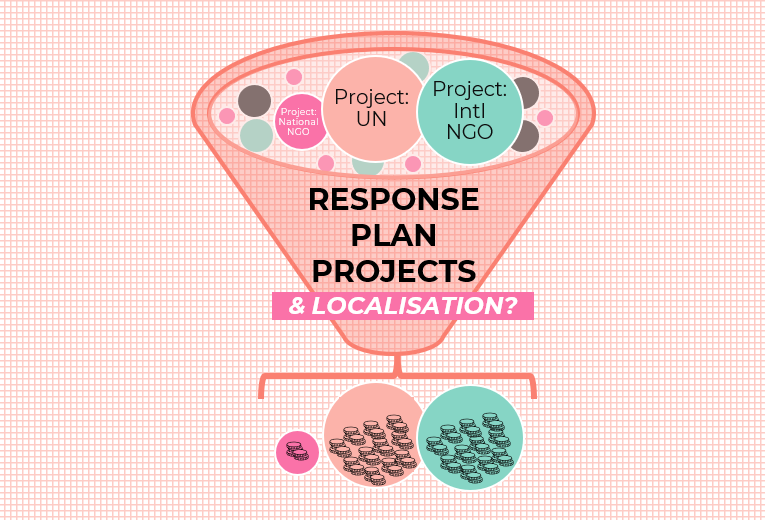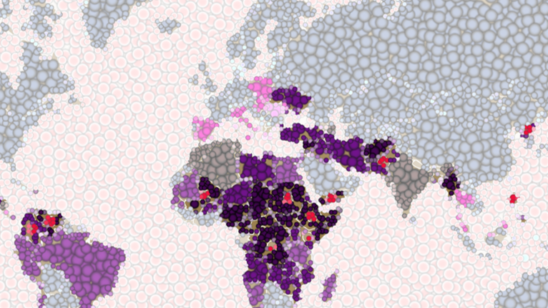
Response Plan Projects: A Red Herring for Localisation6 min read
The thing that sets the rhythm of humanitarian crises (or to be more precise: humanitarian coordination) are response plans. There are different types to do with refugee crises, non-refugee related crises and sudden onset crises – you can learn more about the different types here.
But the one thing that they have in common is that they take up significant amounts of time and resource as organisations coordinate on how to respond to humanitarian needs. But is it worth it for local and national organisations?
In particular, with some response plans, organisations are invited to submit a project that outlines how they will respond to the identified needs, and meets the strategic objectives of the plan. The process should in theory lead to funding for those who have projects (as they have more ‘visibility’ for their organisation and activities, and are also able to leverage the approval of a response plan project).
But the primary purpose is to put a pricetag on the humanitarian response and state how much it is going to cost. For example, the Bangladesh Rohingya Joint Response Plan in 2021 needed $943m to meet the humanitarian needs, and that number is a sum of 186 different proposed projects.
But does this process actually lead to more funding for local and national actors, or is it a time and resource drain?
Asking for small change and getting even less than that
Local and national actors ask for such a small amount of funding in their response plan projects compared to international actors. Of all the funding asked for in response plans with projects, local and national actors ask for 5% of that – $1 in every $20.
Without us even discussing how much funding was actually received, the system has failed for local and national actors. The Grand Bargain target is for 25% of funding to go to local and national actors – but they’re only asking for 5% of all funding.
You can argue that it doesn’t matter because international actors funnel money to local and national actors. That’s a valid point. But it still leads to both an unwelcome dependency on international actors and a power imbalance. It’s not real localisation.
When we look at how much is actually received to response plan projects, local and national actors receive even less than the 5% they ask for. They receive 3% of all funding to response plan projects.
We can break this down even further. Which organisation types had their projects most well funded. The answer is international actors. 52% of funding required was received for projects with 2 or more international actors, UN agencies received 28% of what they asked for (the largest by far in absolute terms: $5.3bn), followed by International NGOs (20%).
The bottom half of the table shows how national NGOs received only 20% of what they asked for, and local NGOs and Red Cross/Crescent societies received only 6% of what they asked for.
But the situation does depend on where you are in the world
Of the 25 contexts with response plan projects (one context isn’t shown below as there was no funding requested for local and national actors), many didn’t receive any funding for local and national actor projects – 12 contexts to be precise.
In fact, only Colombia was a success story here, with local and national actors receiving 57% of what they asked for. There were only four other contexts where local and national actors received at least 10% of what they asked for.
Response plans with projects do marginally better than those without projects
We need to ask a different question at this point. Is it that local and national actor projects are actually better funded when they have projects in the response plan compared to contexts where they don’t?
The answer is that this has some truth, but to a very limited context. Where a context has a response plan with projects, local and national actors receive 2.7% of all project funding. If a context has a response plan without projects, local and national actors receive 1% of all funding.
This would tend to suggest there is a limited positive effect of having a response plan with projects.
However, this gap could be due to reporting. When you consider there is 10% classified as “other”, and a significant part of that is pooled funding where a final destination organisation hasn’t been noted, then some of this could come to local and national actors.
This would therefore lift up local and national actors from the 1% in the graph and make the limited positive effect of having projects even more limited as the gap between the two group closes.
Don’t waste time on projects as a way to advance localisation
When we think about the benefits of response plan projects, there is very limited evidence of response plan projects making a significant, or even a limited difference to local and national actors.
When we think about the costs of response plan projects, it is the time and resource of local and national actors to design, submit, revise and upload projects and budgets.
It’s hard to put an exact breakeven point on this where we can say that the benefits are worth the costs, but given the lack of evidence of a major benefit to local and national actors, there are two conclusions that we can come to.
Firstly, response plan projects are not a way to advance localisation. There is limited benefit of the process to local and national actors, and it doesn’t bring us anywhere near the 25% target of the Grand Bargain.
Secondly, coordination processes such as these need to be localisation-sensitive. If the benefits of the process are limited for local and national actors, we need to think about how we can expand the benefits for local and national actors. Maybe this means making the link between projects and funding stronger for local and national actors through ensuring visibility for them specifically.
If the costs of the process are large for local and national actors, we need to think about how we limit these for them (and for everyone, given the weight of the humanitarian programme cycle).
You can also argue that international actors report funding much more than local and national actors. Whilst this is true it again shows the localisation-insensitivity of our coordination processes. And even if this is an error in the system, there is no reason to believe this would affect response plans with or without projects differently, thus not undermining the point around the lack of benefit in having a response plan with projects.
Response plan projects are a red herring when it comes to localisation. Let’s look for real solutions to advancing localisation, reduce the burden of this process and make our coordination proceses more localisation-sensitive.
Methodology and Sources
Data Source: FTS. Data regarding funding received and funding requirements relating to response plans with projects was extracted on 20th May 2022. Data regarding funding received to response plans without projects was extracted on 25th May 2022.


